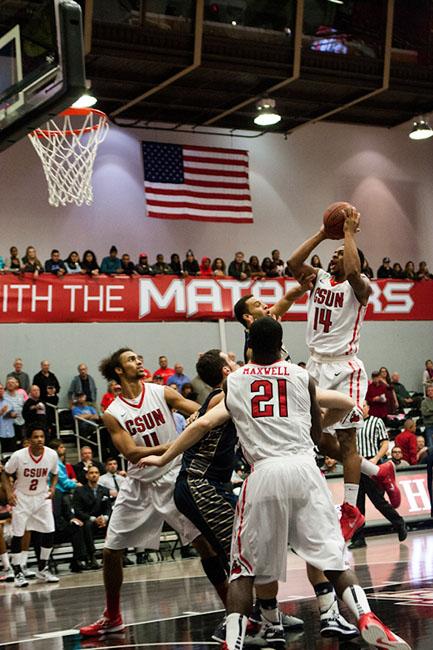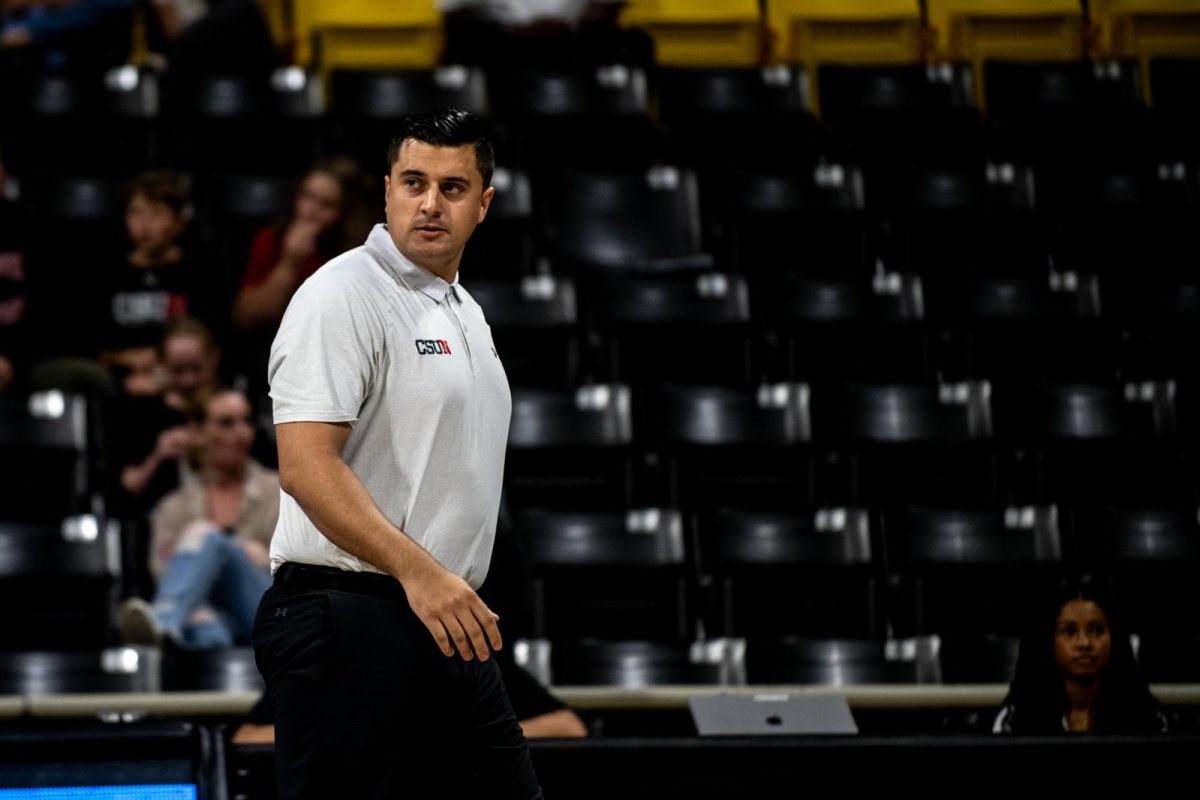As the buzzer sounded in the Matadome following a home loss against UC Santa Barbara (their eighth straight overall), several starters walked off of the floor shaking their heads and shrugging their shoulders.
Even though the disappointment could be seen on the faces of those who played, it was the eight players who were clad in matching black warm-up gear that made the discontent palpable. In what seems to be the result of an ongoing investigation, those players were forced to spend the game sitting on the bench, watching their teammates wear down and relinquish a nine-point lead.
Although the names of the players have not been explicitly stated, freshmen Michael Warren, Tavrion Dawson, Jerron Wilbut, Jibreel Faulkner, Miles-Nolen Webb, as well sophomore KJ Smith and junior Kevin Johnson, have not played since the investigation began, while freshman Zaccary Douglas played only the first two games.
Up to this point, the university has been tight-lipped regarding the investigation, with the exception of a brief statement in early November from CSUN athletic director Brandon E. Martin saying that, “CSUN has elected to sit several basketball players due to potential violations of team rules and University policies until a full and thorough investigation is completed.”
In the three-and-a-half months since that statement was released, there have been no official updates on the investigation, and the same players are still being kept out of games, despite no formal record of any wrongdoing. If it’s taken this long, and there’s still no decision, these young men should be reinstated and allowed to contribute to the program they committed to.
But since those players are still being relegated to spectators, the Matadors have been forced to relinquish the luxury of resting key players for extended periods of time.
“I just don’t think we have enough bodies to give those guys enough breaks so that they’re fresh in the second half,” CSUN head coach Reggie Theus said following a February 5 loss against Cal State Fullerton.
Consequently, the Matadors have had several games where they had six or seven players play at least 20 minutes, meaning by the halfway point of second halves, many key players are winded and fatigued, whereas their opponents are fresher.
More often than not, the fatigue prevents the Matadors from finishing crucial runs.
“There’s no doubt fatigue plays a role,” Theus said after the Matadors blew a second half lead against UC Santa Barbara on Feb. 14. “Every night fatigue plays a role for us.”
The absence of their inactive teammates has not only taken a physical toll on the Matadors, it has also tested their mental and emotional fortitude.
“Whenever we do go into games, and just having eight guys in the layup line, and seeing the other team with their whole roster, it’s tough,” said junior guard Landon Drew, after the Jan. 29 loss to Hawaii.
As a result of the lack of depth, the Matadors have limped to a 7-21 record and one of the most disappointing seasons in recent memory.
Basketball aside, there is an institutional failure on the part of the CSUN. While the administration is taking months to find a resolution, these young men are essentially being held hostage, as they sit out games not knowing what the future holds.
“It’s just ridiculous that it’s gone this long,” Theus said after a Jan. 24 loss to Long Beach State, in reference to the investigation. “To get into it, it’s not worth it.”
It’s not like CSUN has been the only university that has dealt with possible NCAA violations in the middle of a season either.
In 2010, Auburn University was enshrouded in controversy when former quarterback Cameron Newton was involved in a potential “pay for play” recruiting violation. Despite possible violations and sanctions looming, Auburn allowed Newton to play, while an investigation was being done. It wasn’t until the NCAA found that there was some form of wrongdoing that Auburn briefly declared Newton ineligible.
And in the realm of academics, examples like the University of North Carolina at Chapel Hill (UNC) demonstrate that there is no use in immediately punishing current athletes before a formal decision.
In the 2014 UNC case, a report was done by U.S. Justice Department official Kenneth Wainstein which found that 3,100 athletes and other students took certain “sham” classes that allowed them to earn high grades with extreme ease. With such a serious findings, UNC could be looking at serious NCAA violations. However, without an official ruling from the NCAA, they have decided against handcuffing themselves, and have not disciplined any athletes or anybody within athletics in 2014 or 2015.
Conversely, CSUN has passively punished the men’s basketball program by choosing to sit players, although they have not explicitly said who the players are and what the players have done wrong.
Right now, CSUN should take a look at what Auburn and UNC have recently done, because in holding off on punishments, they have protected their school’s “brand,” as well as successful athletic seasons, whereas CSUN has placed a dark cloud over the men’s basketball program, while also bringing into question the competence and integrity of everyone involved.
At this point, “sitting out” players is not the same as suspending players because “sitting out” looks more like an intent to suspend without actually doing so. And if the NCAA comes calling with violations, they will surely not show mercy on an institution that has looked indecisive throughout this whole ordeal.
If the university wants to regain some semblance of respectability, it will finally provide Theus with the help he needs and it should let these young men play.
“Support is important to me from the university,” said Theus after the Jan. 24 loss to Long Beach State. “And I don’t really see that we have any.”






